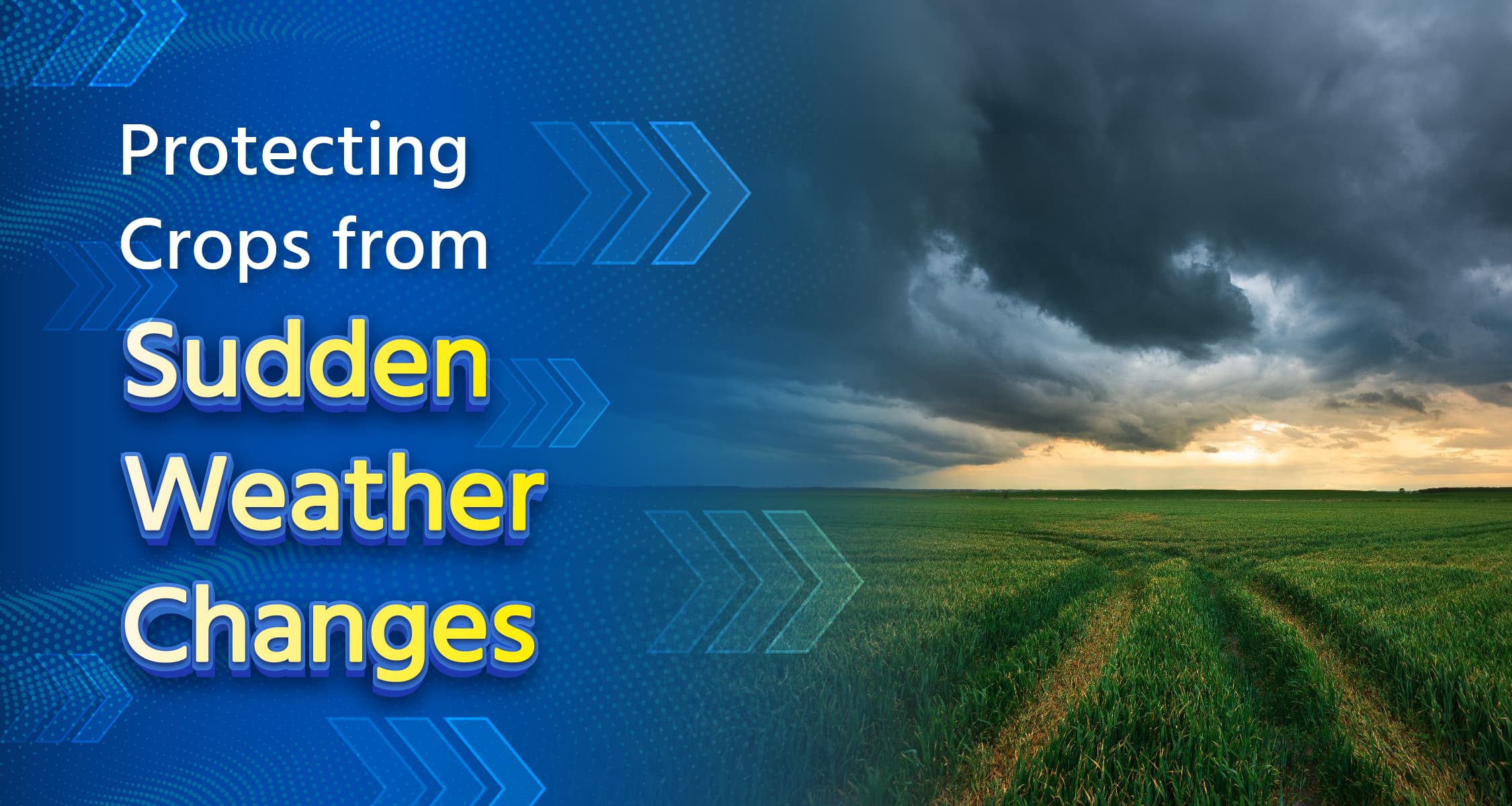Protecting Crops from Sudden Weather Changes

"How to take care of crops in changing weather conditions?" This is an important question that arises in every farmer's mind. Taking care of crops in irregular weather conditions is a challenging task and If weather-appropriate measures are not taken, it can prove detrimental to the crops. Therefore, in this post, we will focus on suitable measures related to various weather conditions that can help farmers in better crop management.
Impact of Weather Changes on Crops
- There may be a decrease in the quantity of flowers and fruits in plants.
- Crops can be susceptible to various diseases and pests.
- Plants can bend or break down due to storms or excessive rainfall.
- Plants can sway and get destroyed.
- There can be hindrances in the growth of plants.
- A significant decrease in crop yield and quality can be observed.
Factors to Consider in Changing Weather
- Forecasting Duration of the Weather: It is essential to forecast the weather and its duration to prevent crops from sudden changes in weather. Knowing what the weather will prevail in the coming days or the possibility of changes in the weather can help farmers plan the proper care of their crops.
- Selecting Appropriate Crops: Based on the estimated weather, farmers should select suitable crops. Before choosing a crop, also ensure that the selected crop is suitable for the weather or whether its production is possible with proper care. This can significantly save crops from damage due to adverse weather conditions.
- Using Regularly Updated Information: During sudden changes in weather, farmers should make use of regularly updated information. Updated weather information can provide accurate information about rain, storms, or other natural emergencies, enabling farmers to properly care for their crops. Farmers can obtain such information from the meteorological department and the nearest agriculture department.
- Develop a Plan for Crop Protection: Creating a plan for crop protection in the event of sudden weather changes is the most important task. This plan can be made based on changes expected in the weather and may include crop protection, irrigation, and fertilizer management. Additionally, disaster management is also necessary in this plan.
- Focus on Natural and Technical Solutions: Farmers should pay attention to natural and technical solutions when anticipating changes in weather. Natural solutions include prioritizing sunlight, utilizing atmospheric residue, and water conservation. Meanwhile, technical solutions involve the use of irrigation systems, managing the correct amount of nutrients, and crop protection.
- Benefit from Official Organizations and Government Schemes: Several official organizations provide farmers with weather information and technical assistance for their assistance. With the help of official organizations, farmers can take proper care of their crops. Additionally, through government schemes, they can also receive compensation for crops lost due to natural disasters.
Care of Crops in Extreme Heat or Heatwaves
- Irrigation: Ensure adequate irrigation for crops during hot weather. Insufficient irrigation can lead to wilting of leaves and potential loss of plants. Drip irrigation is a good option for areas with water scarcity as it conserves water and delivers adequate moisture to the roots.
- Mulching: Mulching is a better option to maintain soil moisture levels. It can also help regulate soil temperature. Additionally, it assists in controlling weeds and preventing soil erosion. You can use plastic sheets available in the market for mulching. Moreover, mulching can also be done with materials like straw, dry leaves, dry grass, etc., at a minimal cost.
- Fertilization: Use appropriate fertilizers to provide essential nutrients to the crops. This enhances the plants' tolerance capacity.
- Protection from Intense Sunlight: Sensitive crops to high temperatures can be protected from intense sunlight by using shade nets or temporary structures.
- Plant Trees: Plant shady trees around the field to provide shade and cool air to the crops from all sides.
Care of Crops in the Rainy Season
- Crop Selection: Choose crops for cultivation in this season that require more water.
- Arrangement for Drainage: Due to inadequate drainage arrangements in the field, waterlogging may occur during the rainy season. Therefore, ensure proper drainage arrangements in the field.
- Irrigation: Do not irrigate when there is moisture in the soil or when rainfall is expected.
- Disease and Pest Management: Due to higher humidity and moisture in the environment during the rainy season, there is a greater chance of the spread of diseases and pests. In such cases, use appropriate pesticides or fungicides for control.
- Soil Loosening: Due to rainfall, the moisture content in the soil increases. In such cases, the soil becomes loose and there is an increased chance of plants falling. To prevent this problem, add soil around the plants and set it properly.
- Use of Nutrients: Use nutrients in the right amount. This will strengthen the roots of the plants and prevent them from falling.
Care of Crops in Extreme Cold
- Irrigation: If there is a possibility of extreme cold (or frost), irrigate the field. Irrigation can increase the temperature of the soil.
- Smoke: Burn dry grass, dry leaves, etc., in the direction of the wind during the evening. This can raise the temperature slightly.
- Barrier: Erect bamboo sticks, plastic sheets, or nets on the northern side of the field. This makes it easier to protect crops from cold winds.
- Use of Nutrient-rich Medicines: Several nutrient-rich medicines are available in the market that can protect crops from the effects of extreme cold/frost.
What methods do you adopt to protect crops from sudden changes in the weather? Share your answers and experiences with us in the comments. For more such information, follow the 'Krishi Gyan' channel now. Also, don't forget to like and share this post.
Frequently Asked Questions (FAQs)
Q: What is the impact of changing weather conditions on crop production?
A: Changing weather conditions affect crop production in India. Plants are destroyed due to natural disasters such as droughts and floods, leading to a significant decrease in yield.
Q: What is climate change and how does it affect agriculture?
A: Climate change deeply affects agriculture in India. It can lead to changes in crop yield, soil health, and water availability. Additionally, the quality of crops can be affected due to natural disasters.
Q: How is agriculture in India affected by climate change?
A: Agriculture in India is highly sensitive to the effects of climate change. The production of crops in our country depends to a large extent on rainfall. Changes in temperature and rainfall patterns can result in decreased crop yields.
जारी रखने के लिए कृपया लॉगिन करें

फसल चिकित्सक से मुफ़्त सलाह पाएँ
